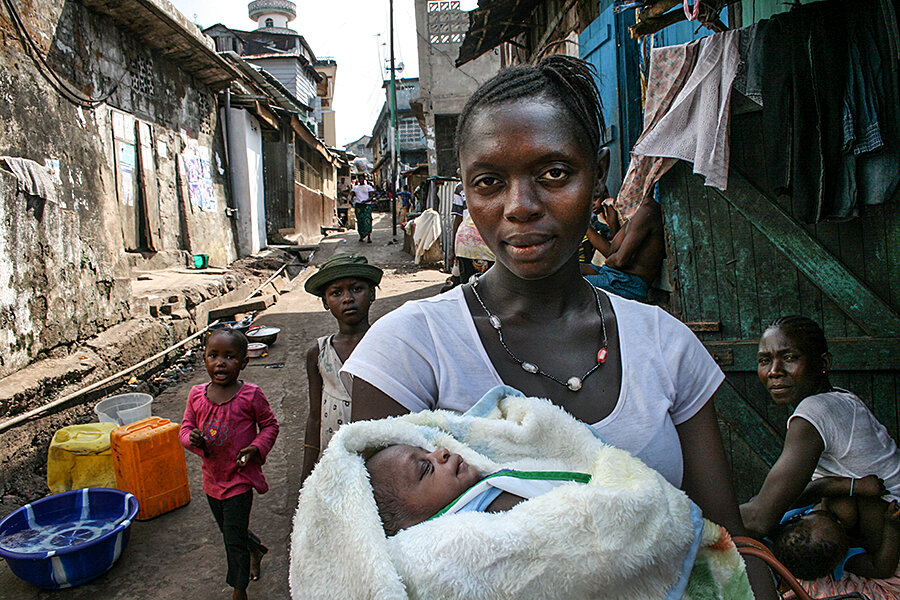Rich mom, poor mom: growing gap in global access to maternal healthcare
Loading...
| Johannesburg, South Africa
Less than six miles separate the crowded public hospital in an industrial district where Emilie Kabala gave birth from the gleaming private clinic in the tree-lined suburb where Rose Rogers had her baby. But in many ways, their daughters were born into different universes.
Ms. Kabala, a Congolese immigrant, spent much of her pregnancy waiting in line at the city’s overstrained public clinics. Ms. Rogers, a TV producer, consulted with midwives and attended prenatal classes that advised on breastfeeding techniques and brands of baby monitors.
Kabala had eight hours after she gave birth to Bernice to vacate her bed in a delivery room crowded with nearly two-dozen other expectant mothers. Rogers and Isabella stayed two days in a private suite. When Bernice fell ill, her mother had to choose between paying rent and buying medicines. When Isabella developed bronchitis, she quickly got appointments with pediatricians and physiotherapists.
Over the past two and a half decades, maternal healthcare around the world has made breathtaking strides: Deaths linked to pregnancy and childbirth are down by 45 percent globally, and the number of young child deaths have been cut in half. But as the overall health of mothers and babies globally has improved in leaps and bounds, a massive gap looms in coverage between the rich and the poor — particularly in the cities of the developing world, according to a report released Monday by Save the Children.
South Africa, with its historically high rates of inequality, offers proof of that divide. Each year, 75,000 children under the age of five die, with nearly two-thirds tied to preventable failures within the public health system, according to UNICEF.
“People around the world come to urban areas because of the opportunities they offer, but in many places there’s a devastating divide between haves and have-nots in the healthcare they are able to access once they arrive,” says Robert Clay, Save the Children’s vice president for health and nutrition. “In many ways, it’s become the survival of the richest.”
Though they may grow up not far from each another, a poor child like Bernice living in cities in Africa, Asia, and Latin America is twice as likely to die as a privileged child like Isabella.
Highs and lows
In several countries, that divide is even greater. In the cities of Peru, Vietnam, and Kenya, the poorest babies die four times as often as the richest. In Cambodia and Rwanda, the rate is five times as high. And in many cities, this divide is increasing, even as the overall healthcare system improves. Kenya, Malawi, and Rwanda, for instance, have all seen their urban child survival gaps double since the 1990s.
This trend extends beyond the developing world. In Washington, D.C. — the Western world’s most unequal capital city for maternal healthcare — a baby born in the most impoverished neighborhoods is ten times as likely to die before her first birthday as a baby born in Ward 3, the city’s wealthiest. In the US, as in much of the developed world, the gap is often correlated with race: An African-American mother in San Francisco, for instance, is six times as likely to lose an infant child as a white mother.
But amid the yawning inequalities, there have also been some notable success stories, even in the world’s poorest corners. In Addis Ababa, Ethiopia’s capital, under-five mortality plunged by half between 2000 and 2011, with almost all of the gains recorded among the city’s poorest. Manila, Cairo, Kampala, Phnom Penh, and Guatemala City have posted similarly staggering gains.
Although no two success stories are the same, Mr. Clay notes that the cities best able to close the gap tend to invest in low-cost public clinics and offer wide access to family planning services and outreach services designed to pull women from the city’s slums into the formal healthcare system.
Migrants suffer most
In much of the world, Clay notes, the women in most desperate need of an outstretched hand are migrants, for whom cultural and linguistic barriers can render hospitals and clinics essentially impenetrable.
Kabala, who came to South Africa from the eastern Congo a year ago, says that sense of intimidation, as well as overt discrimination from South African healthcare professionals, frequently prevented her from accessing the care she needed while pregnant.
“Sometimes when I didn’t know the words to describe what was happening to me, the doctors would tell me they didn’t have time, that I must just leave,” she says.
Before she left Congo with her husband, she was less than a year shy of completing her own medical degree. In Johannesburg their sole income is the $250 he makes each month as an overnight security guard.
For now, however, their two-month old daughter Bernice — born on Valentine’s Day — is healthy and energetic, chattering gibberish to herself as she stares at the ceiling of the slim room she occupies with her parents and aunt in a large shared house.
Six-month-old Isabella is doing very well, too. "She’s had everything she needed,” Rogers says of her daughter. “We know we are very lucky in that way.”








